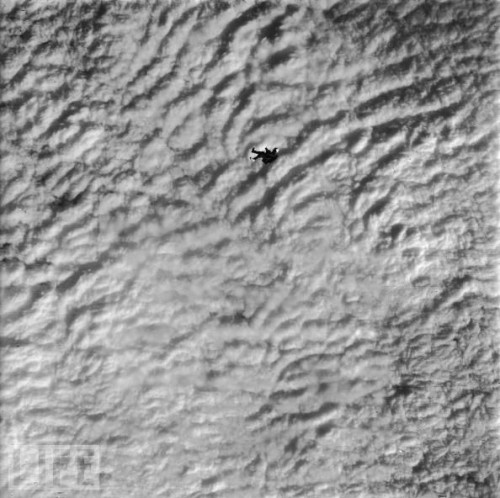5. Joseph Kittinger\’s Leap of Faith
Look carefully: You can just make out Air Force Colonel Joseph Kittinger, Jr. in a record-shattering free fall from the very edge of space on August 16, 1960, after jumping from a balloon-supported gondola 102,800 feet above New Mexico. During his descent, Kittinger reached approximate speeds of 614 miles an hour. The clouds beneath him are 15 miles away. Kittinger\’s leap was part of the Air Force\’s “Project Excelsior,” which conducted research into high altitude bailouts from aircraft. Incredibly, almost 50 years later, Kittinger\’s record for the longest-ever free fall and highest parachute jump still stand.
LIFE: The 21 Greatest Space Photos Ever





Yeesh…did he bring a good book?
Boards of Canada’s music video for Dayvan Cowboy has some video from the jump at the beginning
Wow.
What I want to know is how did he fit his ginormous brass balls into the pressure suit?
Did they get so hot during the freefall as to cause discomfort?
Could they hear the clanging from the ground?
Did they attract lighting?
Yeah that redefines the quote “balls of steel”
Damn.
wots terminal velocity up there?
Terminal velocity of a human is 117-125mph in random posture. If the human has uses the bullet shaped position, (sometimes used by experienced sky divers or seen in movies), there terminal velocity can reach speeds up to 210mph.
Terminal velocity is when the gravity force upon an object is equal to that of the wind resistance.
Downforce (gravity)=Upforce (wind resistance)
Therefore, the aerodynamics/surface area of an object greatly affects the terminal velocity.
source: yahoo answers.
before i looked it up i kind of thought/remembered terminal velocity as being around 124MPH. terminal velocity is just that, terminal, as in final. i call mad shenanigans on the 614MPH bullcrap.
You’d be wrong.
You’ve assumed that air resistance (the reason for terminal velocity) is constant. It’s not. It decreases with altitude. I skydive regularly (pics at skwrl.smugmug.com) In a standard (non-wingsuit) freefall, I go ~130mph, but that’s only because I am jumping at less than 14,000 feet typically.
Did you take into consideration the size of this mans balls? That defeats your ‘yahoo answers’ shenanigans.
mad props for his major high altitude jump, just cause the numbers are off does not mean his balls are smaller or made of less than steel. i’d certianly never do it, but terminal velocity is set, once you reach it you cannot fall faster. i’m suprised i was the first to look it up. imagine opening a paracute at 614MPH, the shock from the decelleration from near supersonic speeds would launch your brains out of your toes i imagine. not to mention more broken bones than eval keniveal during his whole career. at once.
At 102,000 feet I don’t think there is much wind resistance. That speed may have been possible the first 10-20,000 feet, then slowed down as he started descending into thicker air. once into normal air below 35,000 feet would have slowed to what rebel found. But thats my logic… could be waaaaaaaaaaaaaayyy out of line.
But fuck that is faith in your equipment and everyone who worked on that mission.